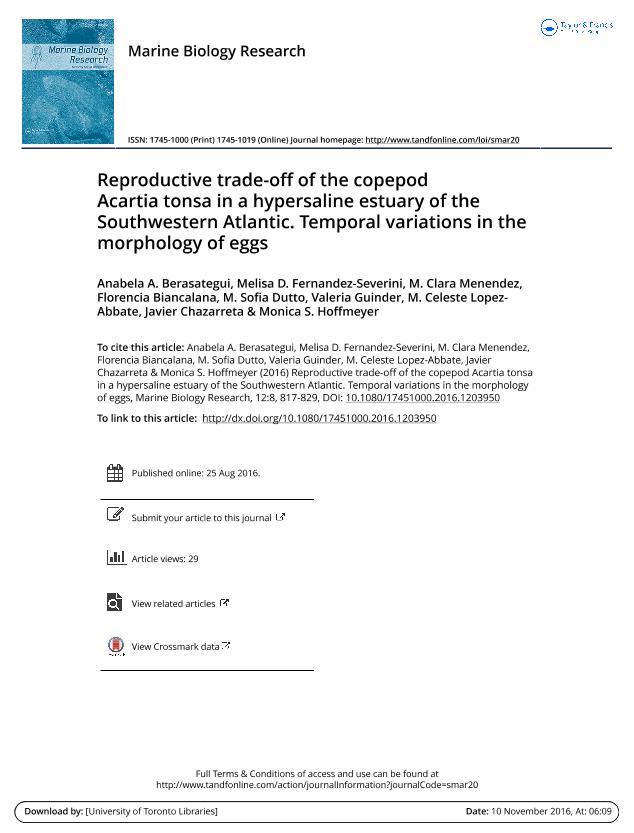Artículo
Reproductive trade-off of the copepod Acartia tonsa in a hypersaline estuary of the Southwestern Atlantic. Temporal variations in the morphology of eggs
Berasategui, Anabela Anhi ; Fernandez Severini, Melisa Daiana
; Fernandez Severini, Melisa Daiana ; Menendez, Maria Clara
; Menendez, Maria Clara ; Biancalana, Florencia
; Biancalana, Florencia ; Dutto, María Sofía
; Dutto, María Sofía ; Guinder, Valeria Ana
; Guinder, Valeria Ana ; López Abbate, María Celeste
; López Abbate, María Celeste ; Chazarreta, Carlo Javier
; Chazarreta, Carlo Javier ; Hoffmeyer, Monica Susana
; Hoffmeyer, Monica Susana
 ; Fernandez Severini, Melisa Daiana
; Fernandez Severini, Melisa Daiana ; Menendez, Maria Clara
; Menendez, Maria Clara ; Biancalana, Florencia
; Biancalana, Florencia ; Dutto, María Sofía
; Dutto, María Sofía ; Guinder, Valeria Ana
; Guinder, Valeria Ana ; López Abbate, María Celeste
; López Abbate, María Celeste ; Chazarreta, Carlo Javier
; Chazarreta, Carlo Javier ; Hoffmeyer, Monica Susana
; Hoffmeyer, Monica Susana
Fecha de publicación:
06/2016
Editorial:
Taylor & Francis As
Revista:
Marine Biology Research
ISSN:
1745-1000
Idioma:
Inglés
Tipo de recurso:
Artículo publicado
Clasificación temática:
Resumen
The purpose of the present work was to study the seasonal variations in egg production, morphology and hatching success in the cryptic species Acartia tonsa, taking into account variations in female size, population abundance and environmental factors in a turbid and hypersaline estuary. Sampling was performed during the austral warm (18–23°C and 32–36 salinity) and cold seasons (5–7°C; 32–38) in Bahía Blanca Estuary (BBE), Argentina, during 2007 and 2009. Field-collected females were incubated in the laboratory simulating in situ environmental conditions, and specimens from fixed samples were measured using optical and scanning electronic microscopy. Acartia tonsa’s marked seasonality in its reproductive traits was found to ensure its permanence in the water column all over the year. During the warm season, small-sized females were observed to invest their energy in the production of subitaneous eggs with high hatching success and smooth appearance (12.95 ± 2.38 eggs f−1 day−1 and specific egg production rate (SEP) of 16.57%C f−1 day−1). During the cold season, females invested C in body mass as well as in the production of resting eggs of three different morphotypes (6.56 ± 3.2 eggs f−1 day−1 and SEP of 7.37%C f−1 day−1). Although these morphotypes were found to show differences in surface ornamentation, they exhibited the same delayed hatching behaviour. The eggs with shorter spines were found to integrate the resting egg bank in BBE. Our findings confirming a delayed egg hatching behaviour and a great tolerance to low temperatures and high salinities in the A. tonsa population in BBE suggest that this possible strain is a valuable phenotype for aquaculture.
Palabras clave:
Acartia Tonsa
,
Seasonal Fecundity
,
Reproductive Plasticity
,
Eggs Morphology
Archivos asociados
Licencia
Identificadores
Colecciones
Articulos(IADO)
Articulos de INST.ARG.DE OCEANOGRAFIA (I)
Articulos de INST.ARG.DE OCEANOGRAFIA (I)
Citación
Berasategui, Anabela Anhi; Fernandez Severini, Melisa Daiana; Menendez, Maria Clara; Biancalana, Florencia; Dutto, María Sofía; et al.; Reproductive trade-off of the copepod Acartia tonsa in a hypersaline estuary of
the Southwestern Atlantic. Temporal variations in the morphology of eggs; Taylor & Francis As; Marine Biology Research; 12; 8; 6-2016; 817-829
Compartir
Altmétricas



